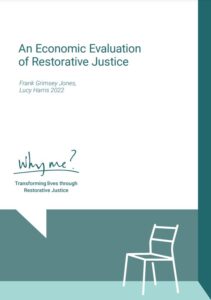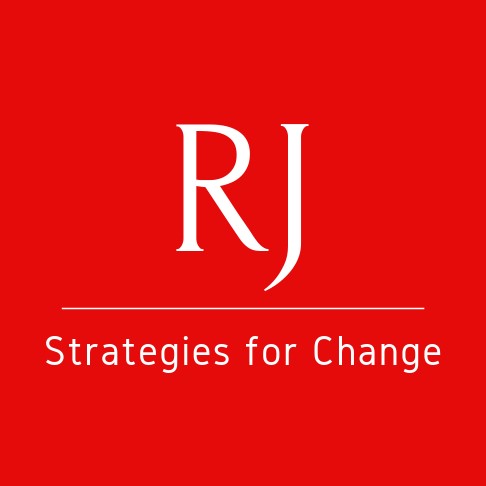Lucy Harris – Why me?
Economic Evaluation of Restorative Justice project
Restorative justice (RJ) has the power to change the lives of all those affected by crime. Why me?’s ambassador stories are powerful examples of its impact on individuals. To promote evidence-based decision making, however, these stories need to be combined with data and research on the economic impact of restorative justice.
In a unique collaboration between Why me? and economist Frank Grimsey Jones, we have used data collected from restorative justice services in England and Wales to carry out a contemporary, holistic and generalisable economic evaluation of restorative justice. We aim to inform the evidence-based development of RJ services that will improve funding of, and access to, RJ interventions. The resulting report and economic model have been published on Why me?’s website.
Why is it necessary to demonstrate the economic benefits of criminal justice interventions?
Reoffending has substantial costs for societies and governments. It also reduces wellbeing for people affected by, or responsible for, offending. In England and Wales, around a quarter of people who are proven to have offended will reoffend within a year, committing an average of three to four offences each (UK Government Database). In 2016, the total economic and social costs of crime were estimated to be £59 billion (Heeks et al., 2018), with reoffending in the first year of follow-up accounting for £18 billion (Newton et al., 2019). Breaking the cycle of reoffending is crucial to reduce the costs of crime, create a more efficient criminal justice system, and improve the lives of those affected.
An economic evaluation of restorative justice
Our evaluation findings demonstrate that the social return on investment in restorative justice is substantial. For every £1 invested in restorative justice in England and Wales, there were £14 of social benefits. The direct return on investment for the criminal justice system was £4 per £1 invested in RJ. This is because RJ substantially reduces reoffending. In our model, each face-to-face RJ intervention reduced the average number of reoffences in the first year from 27 to 19. Overall, our model suggested that a £5 million investment in RJ would be associated with total benefits of £76 million, including savings to the criminal justice system of £17 million.
Although previous research shows that face-to-face restorative justice interventions reduce reoffending (Shapland et al., 2008; Strang et al., 2013), investment in, and access to, RJ remains limited across most of Europe. Our economic evaluation has provided a robust way to demonstrate and model the economic benefit of RJ interventions as related to reduced reoffending and improved wellbeing. Overall, economic evaluations are underutilised in the social sector, but can be a useful and compelling way to influence decision making.
Our economic evaluation provides a significant breakthrough in our ability to make the economic case for restorative justice. As restorative justice researcher Joanna Shapland said of this work:
“A key aspect for anyone considering initiatives benefiting victims or encouraging desistance is whether they are value for money. This in-depth economic analysis of restorative justice takes us much further to answer this question – in a positive direction.”
Our recommendations for future research and policymakers
Our research shows that restorative justice can reduce reoffending, save money and help victims recover. Following these findings, Why me? continue to demonstrate that increasing access to restorative justice should be a policy priority for national and local decision makers within criminal justice systems.
Why me? believe that this can be achieved by implementing a series of recommendations made in the report for policymakers and researchers, including:
- Improved national data collection should be a priority, based on a shared definition of key metrics, including level of investment, number of referrals, number of direct and indirect restorative justice interventions, reoffending rates, and participant wellbeing.
- Governments should enshrine in law right to be given information about and access to restorative justice. There should be no blanket bans on restorative justice provision for specific types of cases, so that all victims of crime are able to decide whether to engage with restorative justice.
- Policymakers should use the model produced by this research to understand the return on investment that restorative justice provides in their jurisdictions. They should share the model with staff and services responsible for restorative justice delivery, and establish an action plan to ensure consistent data collection and analysis, in order to understand and improve the return on investment.
You can read the published report and economic model here. If you’re interested in hearing more about the research, or need any assistance with using the model, please get in contact via info@why-me.org.
Heeks, M., Reed, S., Tafsiri, M. & Prince, S. (2018). The economic and social costs of crime Second edition.
Shapland, J., Atkinson, A., Atkinson, H., Dignan, J., Edwards, L., Hibbert, J., Howes, M., Johnstone, J., Robinson, G. & Sorsby, A. (2008). Does restorative justice affect reconviction? The fourth report the evaluation of three schemes. National Offender Management Service.
Strang, H., Sherman, L. W., Mayo‐Wilson, E., Woods, D. & Ariel, B. (2013). Restorative Justice Conferencing (RJC) Using Face‐to‐Face Meetings of Offenders and Victims: Effects on Offender Recidivism and Victim Satisfaction. A Systematic Review. Campbell Systematic Reviews, 9(1), 1–59.
Newton, A., May, X., Eames, S. & Ahmad, M. (2019). Economic and social costs of reoffending: Analytical report.
UK Government Database. (n.d.). GOV.UK. https://www.gov.uk
